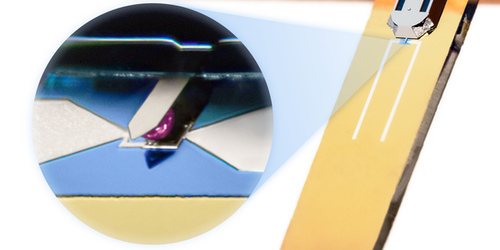A Nonlinear Cavity Cools a Cantilever
Individual photons can impart tiny, highly controllable amounts of radiation pressure on mechanical objects, making optomechanical devices a platform of choice for precision sensors and for tests of fundamental physics. To operate an optomechanical device in the quantum regime, researchers must cool the mechanical component to its ground state, which they commonly achieve by coupling the oscillator to a so-called linear optical cavity. Now David Zoepfl of the University of Innsbruck, Austria, and his colleagues show that switching the linear cavity with a nonlinear cavity can dramatically enhance the efficiency of this cooling [1]. The team says that its approach could be particularly useful for high-mass mechanical systems, which are difficult to cool with current techniques.
The team’s system consists of a superconducting optical cavity inductively coupled to a magnetic cantilever. The cavity has a nonlinear response to light intensity, meaning that as the number of photons in the cavity increases, the cavity frequency decreases.
In the experiments, Zoepfl and colleagues excited photons in the cavity using microwave radiation. This process altered the oscillator-cavity coupling strength as well as the intensity of the cavity’s nonlinear response to a magnetic field. They found that the amplitude of the cantilever’s thermal fluctuations decreased more rapidly for their nonlinear cavity than for a linear one. They also showed that they could cool the cantilever to an effective temperature an order of magnitude lower than that possible with a linear cavity under equivalent conditions.
The team is now looking into ways to further enhance the cooling by using the technique to reach the effective temperatures needed to study higher-mass systems at their quantum limits.
–Rachel Berkowitz
Rachel Berkowitz is a Corresponding Editor for Physics Magazine based in Vancouver, Canada.
References
- D. Zoepfl et al., “Kerr enhanced backaction cooling in magnetomechanics,” Phys. Rev. Lett. 130, 033601 (2023).




